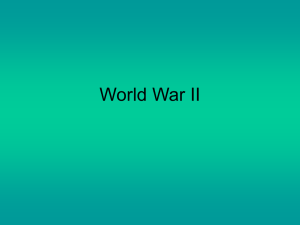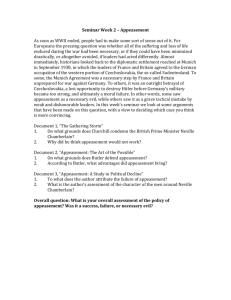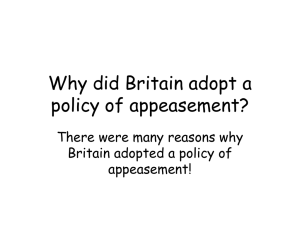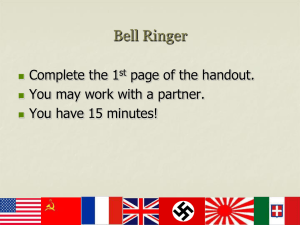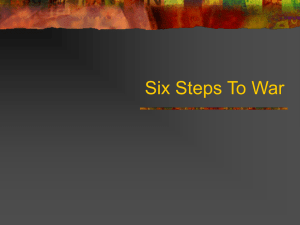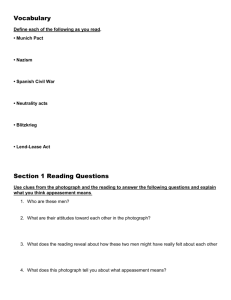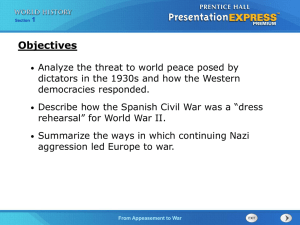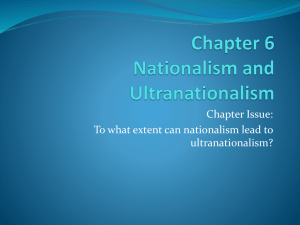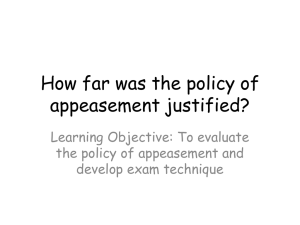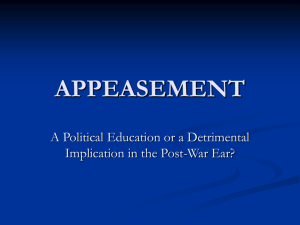Appeasement Handout - University of Leeds
advertisement
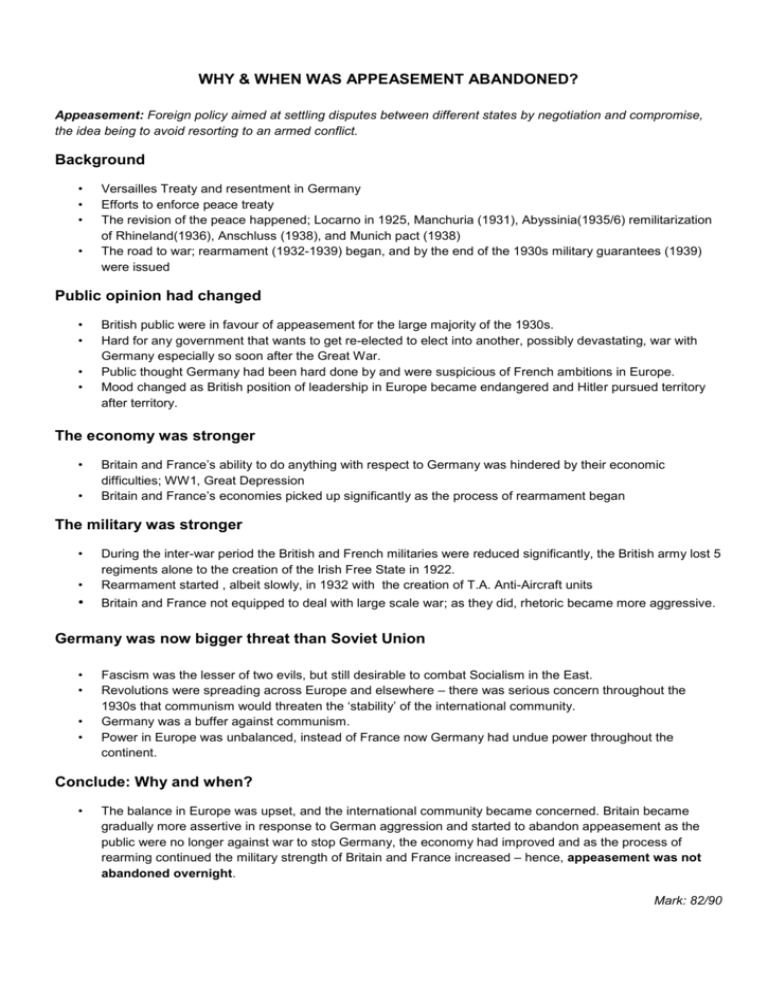
WHY & WHEN WAS APPEASEMENT ABANDONED? Appeasement: Foreign policy aimed at settling disputes between different states by negotiation and compromise, the idea being to avoid resorting to an armed conflict. Background • • • • Versailles Treaty and resentment in Germany Efforts to enforce peace treaty The revision of the peace happened; Locarno in 1925, Manchuria (1931), Abyssinia(1935/6) remilitarization of Rhineland(1936), Anschluss (1938), and Munich pact (1938) The road to war; rearmament (1932-1939) began, and by the end of the 1930s military guarantees (1939) were issued Public opinion had changed • • • • British public were in favour of appeasement for the large majority of the 1930s. Hard for any government that wants to get re-elected to elect into another, possibly devastating, war with Germany especially so soon after the Great War. Public thought Germany had been hard done by and were suspicious of French ambitions in Europe. Mood changed as British position of leadership in Europe became endangered and Hitler pursued territory after territory. The economy was stronger • • Britain and France’s ability to do anything with respect to Germany was hindered by their economic difficulties; WW1, Great Depression Britain and France’s economies picked up significantly as the process of rearmament began The military was stronger • • During the inter-war period the British and French militaries were reduced significantly, the British army lost 5 regiments alone to the creation of the Irish Free State in 1922. Rearmament started , albeit slowly, in 1932 with the creation of T.A. Anti-Aircraft units • Britain and France not equipped to deal with large scale war; as they did, rhetoric became more aggressive. Germany was now bigger threat than Soviet Union • • • • Fascism was the lesser of two evils, but still desirable to combat Socialism in the East. Revolutions were spreading across Europe and elsewhere – there was serious concern throughout the 1930s that communism would threaten the ‘stability’ of the international community. Germany was a buffer against communism. Power in Europe was unbalanced, instead of France now Germany had undue power throughout the continent. Conclude: Why and when? • The balance in Europe was upset, and the international community became concerned. Britain became gradually more assertive in response to German aggression and started to abandon appeasement as the public were no longer against war to stop Germany, the economy had improved and as the process of rearming continued the military strength of Britain and France increased – hence, appeasement was not abandoned overnight. Mark: 82/90 The Research Process Sources Use a variety of sources to understand the question. Journals usually discuss recent debates concerning the subject area o JSTOR, e.g. The Journal of International Security o Example Reference MHRA: Macdonald, P. K., and J. M. Parent, ‘Graceful Decline: The Surprising Success of Great Power Retrenchment’, in International Security, 35. 4 (2011), 7-44. Harvard: MACDONALD, P. K., J.M. PARENT. 2011. Graceful Decline: The Surprising Success of Great Power Retrenchment. International Security. 35(4), pp. 7-44. Books/Monographs provide an in-depth resource of information, and no high mark can be achieved without them o Use http://lib.leeds.ac.uk to search for books. If you wanted to search for appeasement, like I did in for my presentation, then don’t just search for appeasement. Search for a specific subject within that topic. o Also ask your module tutors for books they recommend if there is an extensive reading list or no reading list at all. o Example Search Soviet Union and appeasement / France and appeasement The internet is a great resource for newspapers and magazines Use the Special Collections at the University of Leeds – rare books make your bibliography impressive. Generally, the more sources you read, the more you learn, the better the understanding of the issues, the better the argument, the more impressive the bibliography, the better the mark. Being able to write an essay is a pre-requisite of going to university. Combine these two, and you should access the firsts. In another essay I wrote recently, for 2200 words, I had 40 references. In this presentation, I read 12-15 different sources. Style of Presentation The presentation should not have blocks of text from people to read – you’re presenting not dictating. Use imaginative images, for instance in this I used a word cloud generator, and then used photo imaging software (Photoshop) to enhance the header you see on each page. Make the background dark in colour and the text light as this provides a high contrast between the two, it makes it easier to read. Engage the audience by asking their hands on an aspect of the presentation, for example I asked my audience if they thought appeasement ended when a) rearmament began b) when the Munich Crisis happened, c) when war was declared or d) when fighting began. Handout The handout needs to summarise what you said, and not be a word for word account for what you said. Ensure that you have a handout and a reader sheet – the reader sheet is more comprehensive than the handout and is what you quickly glance to when presenting. Break each slide down into a point on a handout (as you can see above) Reader Sheet Rehearse your presentation beforehand. Do not just read off the reader sheet – this is solely there to guide you if you become stuck on a particular point. You should know, as a result of the reading and the write up of the handout/reader sheet/PowerPoint presentation, everything you’re talking about. This should mean you don’t have to be reading from a sheet of paper – generally speaking, the more you simply ‘read out’ a presentation, the more unlikely it becomes you can reach a good first. Knowing what you’re presenting makes the difference – it will show when asked questions by the audience. The reader sheet is a walkthrough of your presentation.
